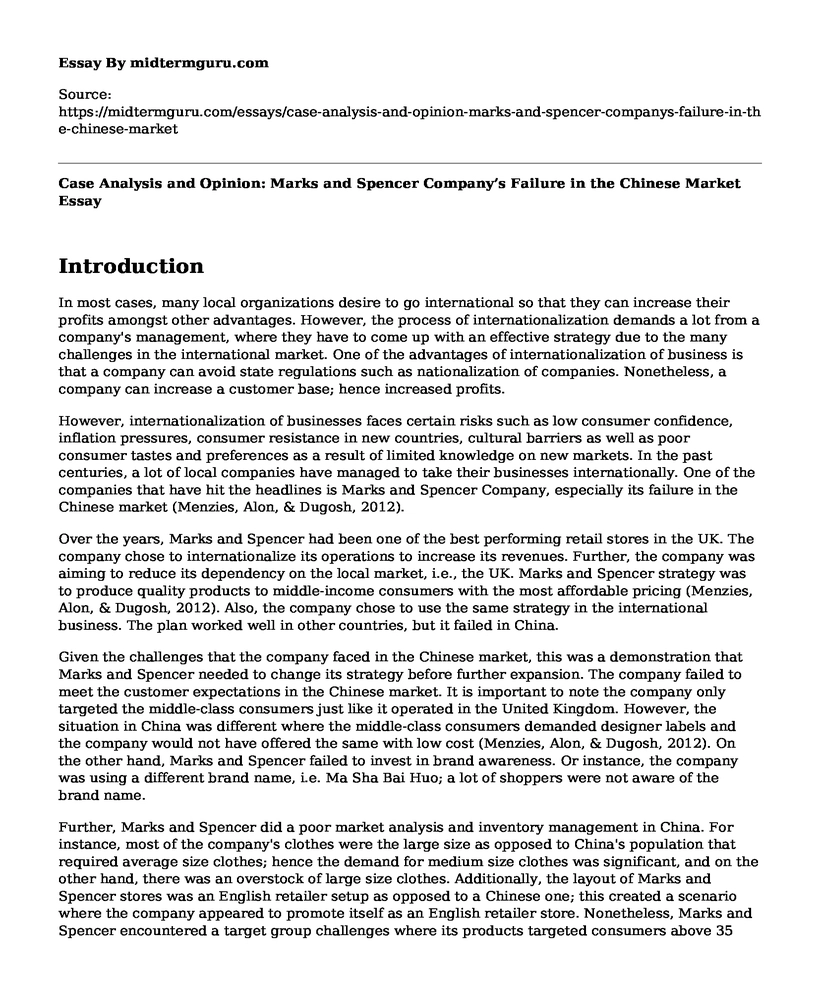Introduction
In most cases, many local organizations desire to go international so that they can increase their profits amongst other advantages. However, the process of internationalization demands a lot from a company's management, where they have to come up with an effective strategy due to the many challenges in the international market. One of the advantages of internationalization of business is that a company can avoid state regulations such as nationalization of companies. Nonetheless, a company can increase a customer base; hence increased profits.
However, internationalization of businesses faces certain risks such as low consumer confidence, inflation pressures, consumer resistance in new countries, cultural barriers as well as poor consumer tastes and preferences as a result of limited knowledge on new markets. In the past centuries, a lot of local companies have managed to take their businesses internationally. One of the companies that have hit the headlines is Marks and Spencer Company, especially its failure in the Chinese market (Menzies, Alon, & Dugosh, 2012).
Over the years, Marks and Spencer had been one of the best performing retail stores in the UK. The company chose to internationalize its operations to increase its revenues. Further, the company was aiming to reduce its dependency on the local market, i.e., the UK. Marks and Spencer strategy was to produce quality products to middle-income consumers with the most affordable pricing (Menzies, Alon, & Dugosh, 2012). Also, the company chose to use the same strategy in the international business. The plan worked well in other countries, but it failed in China.
Given the challenges that the company faced in the Chinese market, this was a demonstration that Marks and Spencer needed to change its strategy before further expansion. The company failed to meet the customer expectations in the Chinese market. It is important to note the company only targeted the middle-class consumers just like it operated in the United Kingdom. However, the situation in China was different where the middle-class consumers demanded designer labels and the company would not have offered the same with low cost (Menzies, Alon, & Dugosh, 2012). On the other hand, Marks and Spencer failed to invest in brand awareness. Or instance, the company was using a different brand name, i.e. Ma Sha Bai Huo; a lot of shoppers were not aware of the brand name.
Further, Marks and Spencer did a poor market analysis and inventory management in China. For instance, most of the company's clothes were the large size as opposed to China's population that required average size clothes; hence the demand for medium size clothes was significant, and on the other hand, there was an overstock of large size clothes. Additionally, the layout of Marks and Spencer stores was an English retailer setup as opposed to a Chinese one; this created a scenario where the company appeared to promote itself as an English retailer store. Nonetheless, Marks and Spencer encountered a target group challenges where its products targeted consumers above 35 years while the largest middle-class consumer group in China comprised of individuals between 18 and 34 years (Menzies, Alon, & Dugosh, 2012).
Conclusion
The company was supposed to revise its marketing strategy. For instance, the layout of its stores would have demonstrated a Chinese culture. It was absurd to use a Chinese brand name with an English retailer layout. Also, the company was supposed to conduct a thorough market analysis to gain a deeper understanding of the consumer tastes and preferences in China. Lastly, the company would have invested in its brand awareness through increased advertisement.
Reference
Menzies, J., Alon, L., & Dugosh, J. (2012). Marks and Spencer Enters China. Ivey, 1-18.
Cite this page
Case Analysis and Opinion: Marks and Spencer Company's Failure in the Chinese Market. (2022, Sep 13). Retrieved from https://midtermguru.com/essays/case-analysis-and-opinion-marks-and-spencer-companys-failure-in-the-chinese-market
If you are the original author of this essay and no longer wish to have it published on the midtermguru.com website, please click below to request its removal:
- Corporation of the Presiding Bishop v Amos Case
- Evaluation Essay on Blockbuster Company
- Paper Example on Amazon's Strategy for Growth
- Article Analysis Essay on Factors Affecting Business Success of Small and Medium Enterprises
- Intern at Guards Polo Club: Managing Payrolls, Staff, Vendors & More - Essay Sample
- Overcoming Resistance: Managing Change in Organizations - Essay Sample
- Toyota's Environmental Pollution: Ethical Actions & Behaviour - Research Paper







